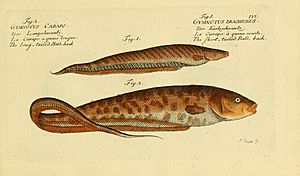Banded knifefish facts for kids
Quick facts for kids Banded knifefish |
|
|---|---|
 |
|
 |
|
| Old illustrations (uppermost showing shape well, lower typical colors) | |
| Scientific classification |
The banded knifefish (Gymnotus carapo) is a unique fish found in many freshwater places across South America. It's known for its long, flat body that looks a bit like a knife. This fish is the most common type of Gymnotus knifefish. Sometimes, people use the name "banded knifefish" for all fish in the Gymnotus group, not just G. carapo.
Where They Live
This fish lives in many rivers and basins in South America. You can find it in the Amazon, Orinoco, and Río de la Plata areas. It also lives in rivers in the Guianas, parts of northeastern Brazil, and northern Argentina. You can even find it on the island of Trinidad. Because it's found in so many places, it's the most widespread Gymnotus species.
Banded knifefish can live in almost any freshwater spot. This includes rivers, streams, floodplains, swamps, and lakes. They are very tough! They can breathe air from the water's surface if there isn't much oxygen. They can even survive on land for a short time if their water dries up.
What They Look Like
The banded knifefish can grow up to 76 cm (30 in) long. But usually, they are smaller, around 15–26 cm (6–10 in). They are brown with slanted stripes or bands on their bodies. The look of these bands can be a bit different from one fish to another, and also depends on where they live.
Scientists have studied these differences. They found that even though fish from different places might look a little different, they are still the same species. However, some scientists think these different groups could be called subspecies.
How They Behave
Banded knifefish are special because they are "electric fish." This means they can make a weak electric field around themselves. They use this field to find their way around, hunt for food, and talk to other knifefish. If another knifefish comes too close, they can feel its electric field and might act aggressively. But don't worry, they can't make a strong electric shock like an electric eel to hurt other animals.
These fish are nocturnal, which means they are most active at night. They like to eat small creatures that live at the bottom of the water. This includes worms, insects, small crabs, and even tiny fish.
When it's time to have babies, the male banded knifefish is a great dad! He makes a small dip in the bottom of the water, which is like a nest. The female lays her eggs there. Then, the male takes care of the eggs and even holds the young fish in his mouth to keep them safe.
See also
 In Spanish: Gymnotus carapo para niños
In Spanish: Gymnotus carapo para niños

